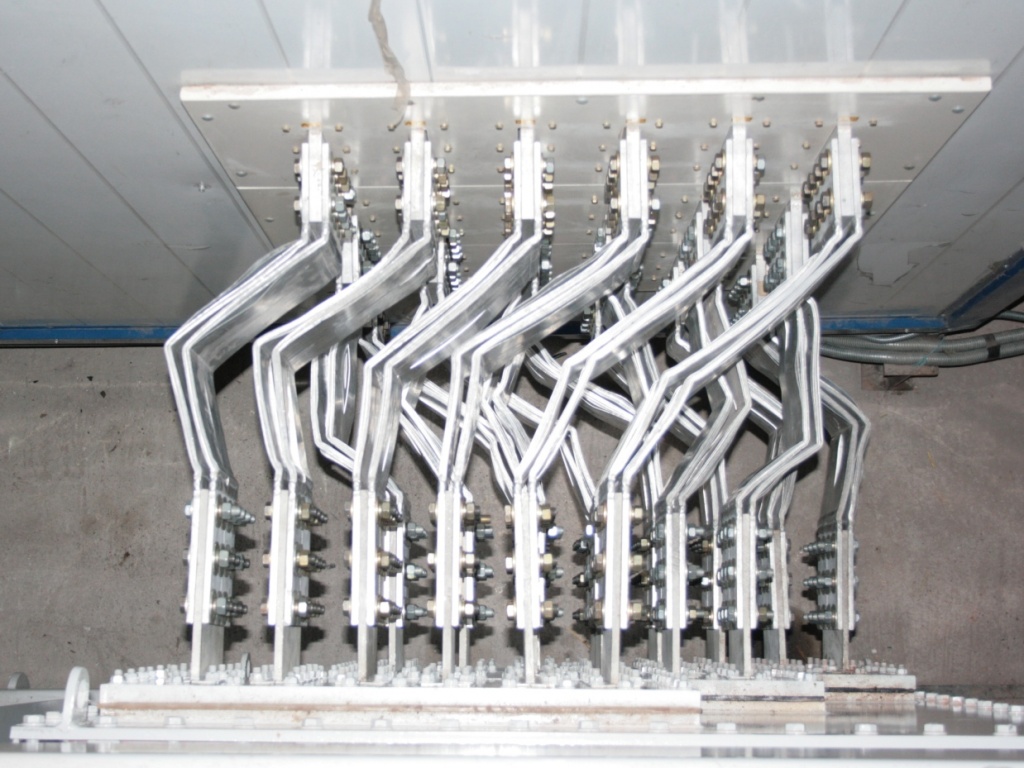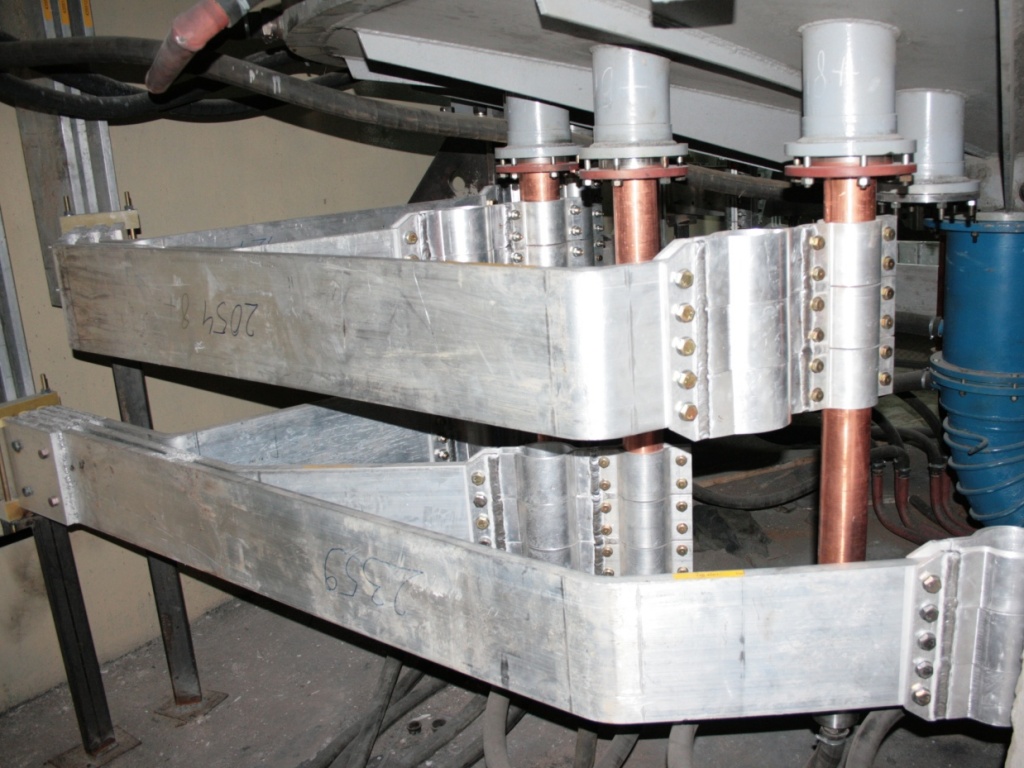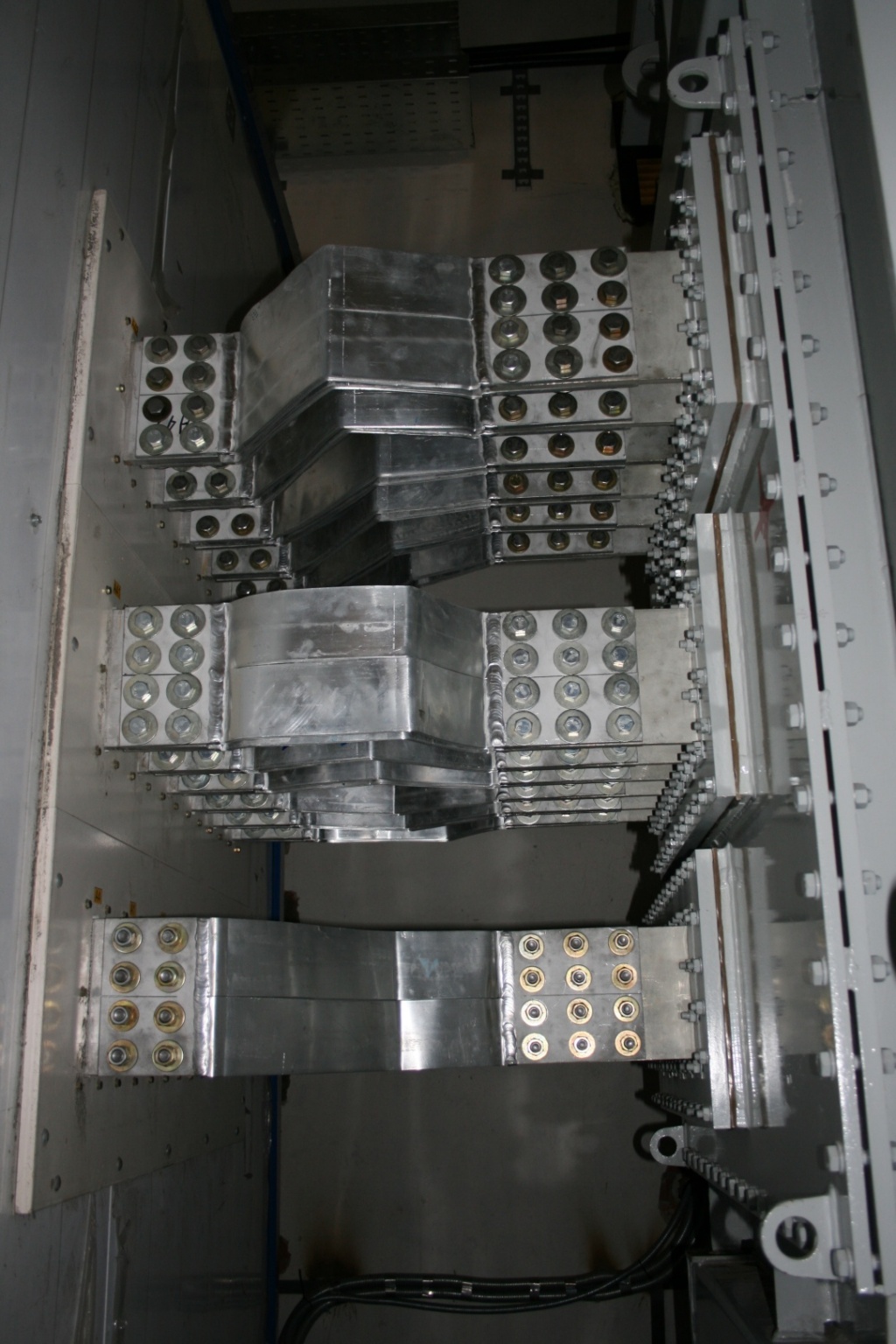Busbars & Power Connections
Copper and aluminium bus bars for currents up to 300000A
 Application
Application
Intended for connecting the transformers, generators, high power rectifier units to consumers – motors, resistor furnaces, arc furnaces, electrolysis and electroplating baths, etc.
Operating in mains rated up to 1500V.
Used in
– transformers;
– switchgears;
– rectifiers;
– switching apparatus, motors;
– d.c. power supply systems of high power consumers;
– electrodes, input leads in electrolyzers.
Design
 Bus bars for large currents – are non – standard products, which are designed and calculated for every particular consumer according to agreed upon specifications.
Bus bars for large currents – are non – standard products, which are designed and calculated for every particular consumer according to agreed upon specifications.
Component parts
The bus bars are assembled of separate sections. The bus bars sections consist of non – insulated packs of aluminium buses laid in insulators – cleats and secured together in yokes. The yokes are connected by support angles, which are used for fastening and earthing the bus bars.
The bus bars are delivered completely factory assembled, in compliance with the order specification prepared according to the working drawing of the design project. The bus bars are characterized by high availability for service, high field reliability and convenient maintenance.
The bus bar terminals are mechanically shock – absorbing due to flexible connectors (compensators), the butt welded joints being done under the factory conditions.
Coatings of contact surfaces
The surface of the bus bars in the joints type aluminium – copper or aluminium – aluminium are coated by nickel, which ensures long – time steady – state contact connections.
 Length of bus bar
Length of bus bar
Total length of a bus duct may run to 100m and above.
Additional options
– erection
Fabrication of bus bar
– according to developed and designed documentation or to the Customer's drawings.
Material
The material of bus bars, copper or aluminium, are usually aluminium alloys AD0, AD31, AD31T.
Recommendations
Basing upon our longer than 50 years experience we advise our Customers to use bus bars made of aluminium alloy practically in all cases, even in corrosive atmosphere.
Advantages of aluminium bus bars over copper ones:
– aluminium is much more suitable for being subject to machining, than copper;
– welding of aluminium is much simpler, than that of copper, due to the smaller thermal conductivity;
– aluminium is 3,29 times lighter than copper and, though its specific conductivity is 1,57 times worse than that of copper, the specific weight per 1 ampere is 3,3 times less;
– the price of aluminium by September 27, 2010, according to data of London Metal Exchange, is $2233,5, price for copper is $7876,5, thus aluminium is 3,5 times cheaper, than copper (Table 1);
– the cost of works for mounting aluminium buses is considerably less, than the cost of mounting copper buses.
Comparison of copper and aluminium conductors:
Table 1. Specification of metals
| Specification of metals | Aluminium | Copper |
|---|---|---|
| Specific weight, g/cm3 | 2,7×103 | 8,93×103 |
| Specific conductivity at 20 °С, cm/m | 37 000 000 | 58 100 000 |
| Price of metal LME, $ | 2233,5 | 7876,5 |
| Price of product in Russia (bus 10×100 mm), $/ton
| 4530
| 10660
|
However, a lot of Customers prefer copper buses to aluminium ones justifying it, that a corrosive medium is present in their plants, such as acid fumes, electrolyte, etc. Particularly insistent about it are European engineering companies.
We can suggest three arguments in favour of our standpoint:
– it is makes no difference for electric current, whether it is running through a copper or an aluminium bus, the main thing being the correct calculation of the cross section;
– project recovery expenses: due to smaller cost of the aluminium buses and of the mounting and erection works the investments pay back faster, while the cost of the long buses holds not a small share in the total cost of the equipment;
– experience of using aluminium buses in the plants now in operation; for example: on plant "Elektrozink", Vladikavkaz, the buses running from rectifier sets to electrolyses baths made of aluminium alloy AD31T, have been operating successfully for more than 50 years, since foundation of the plant.
Current density and power loss
Depending on the value of loss and current density the cost of the unit is varying towards rising or lowering.
Taking into account the prices for Al and Cu and considering the fact, that the current density for aluminium conductors is within the limits of 0,4 to 0,5 A/mm2, for copper from 0,9 to 1 A/mm2, it is seen from Table 2, that aluminium conductor, by its thermal, electric and price characteristics, is more competitive for some applications (branches).
Table 2. Direct current loss
|
Copper at 50 °C ρ=0,02 |
Aluminium at 50 °C ρ=0,032 | ||||||||||
|---|---|---|---|---|---|---|---|---|---|---|---|
| Current density, A/mm 2
| Loss for 1kA and 1m length, W
| Current density, A/mm 2
| Loss for 1kA and 1m length, W
| ||||||||
| 0,8
| 16
| 0,3
| 9,6
| ||||||||
| 0,85 | 17 | 0,35 | 10,2 | ||||||||
| 0,9 | 18 | 0,4 | 12,8 | ||||||||
| 0,95 | 19 | 0,45 | 14,4 | ||||||||
| 1,0 | 20 | 0,5 | 16,0 | ||||||||
| 1,05 | 21 | 0,55 | 17,6 | ||||||||
| 1,1 | 22 | 0,6 | 19,2 | ||||||||
| 1,15 | 23 | 0,65 | 20,8 | ||||||||
| 1,2 | 24 | 0,7 | 22,4 | ||||||||
| 1,25 | 25 | 0,75 | 24,0 | ||||||||
| 1,3 | 26 | 0,8 | 25,6 | ||||||||
| 1,35 | 27 | 0,85 | 27,2 | ||||||||
| 1,4 | 28 | 0,9 | 28,8 | ||||||||
| 1,45 | 29 | 0,95 | 30,4 | ||||||||
| 1,5 | 30 | 1,0 | 32,0 | ||||||||
| 1,6 | 32 | 1,1 | 35,2 | ||||||||
| 1,7 | 34 | 1,2 | 38,4 | ||||||||
| 1,8 | 36 | 1,3 | 41,6 | ||||||||
| 1,9 | 38 | 1,4 | 44,8 | ||||||||
| 2,0 | 40 | 1,5 | 48,0 | ||||||||
Weight of copper and aluminium conductors
It is seen from Table 3, that aluminium is by 70% (or 3,29 times) lighter, than copper, which makes the bus arrangement more light and turns out to be a deciding factor while choosing less expensive version of the plant.
Table 3. Weight of copper and aluminium conductors.
| Cross section, mm 2 | Weight of copper, kg/m | Weight of aluminium, kg/m |
|---|---|---|
| 1000 | 8,9 | 2,7 |
| 2000 | 17,8 | 5,4 |
| 3000 | 26,7 | 8,1 |
| 4000
| 35,6
| 10,8
|
| 5000 | 44,5 | 13,5 |
| 6000 | 53,4 | 16,2 |
| 7000 | 62,3 | 18,9 |
| 8000 | 71,2 | 21,6 |
| 9000 | 80,1 | 24,3 |
| 10000 | 89,0 | 27,0 |
| 11000 | 97,9 | 29,7 |
| 12000 | 106,8 | 32,4 |
| 13000 | 115,7 | 35,1 |
| 14000 | 124,6 | 37,8 |
| 15000 | 133,5 | 40,5 |
| 16000 | 142,4 | 43,2 |
| 17000 | 151,3 | 45,9 |
| 18000 | 160,2 | 48,6 |
| 19000 | 169,1 | 51,3 |
| 20000 | 178,0 | 54,0 |
Thermal expansion of aluminium and copper
In connection with the fact, that thermal expansion acts upon the performance and operation of d.c. conductors, this should be considered in the process of designing the plants and while maintaining their service conditions. Varying of temperatures between operating and inoperative state of the installation, between the summer and winter temperatures is within 60 to 70 °C. Thus, it is seen from the Table 4, that the temperature difference causes displacement of the bus assemblies from 20 to 40 mm.
Table 4. Thermal expansion, mm
|
|
Length of bus, m | |||||||||||
|---|---|---|---|---|---|---|---|---|---|---|---|---|
| ∆t [°С] |
Copper |
Aluminium | ||||||||||
| 5 | 7,5 | 10 | 15 | 20 | 30 | 5 | 7,5 | 10 | 15 | 20 | 30 | |
| 10 | 0,85 | 1,275 | 1,70 | 2,55 | 3,40 | 5,10 | 1,2 | 1,8 | 2,4 | 3,6 | 4,8 | 7,2 |
| 20 | 1,7 | 2,55 | 3,40 | 5,10 | 6,80 | 10,20 | 2,4 | 3,6 | 4,8
| 7,2 | 9,6 | 14,4 |
| 30 | 2,55 | 3,825 | 5,10 | 7,65 | 10,20 | 15,30 | 3,6 | 5,4 | 7,2 | 10,8 | 14,4 | 21,6 |
| 40 | 3,40 | 5,10 | 6,80 | 10,20 | 13,60 | 20,40 | 4,8 | 7,2 | 9,6 | 14,4 | 19,2 | 28,8 |
| 50 | 4,25 | 6,375 | 8,50 | 12,75 | 17,00 | 25,50 | 6,0 | 9,0 | 12,0 | 18,0 | 24,0 | 36,6 |
| 60 | 5,10 | 7,65 | 10,20 | 15,30 | 20,40 | 30,60 | 7,2 | 10,8 | 14,2 | 21,6 | 28,8 | 43,2 |
| 70 | 5,95 | 8,925 | 11,90 | 17,85 | 23,80 | 35,70 | 8,4 | 12,6 | 16,8 | 25,2 | 33,6 | 50,4 |
Назад в раздел
